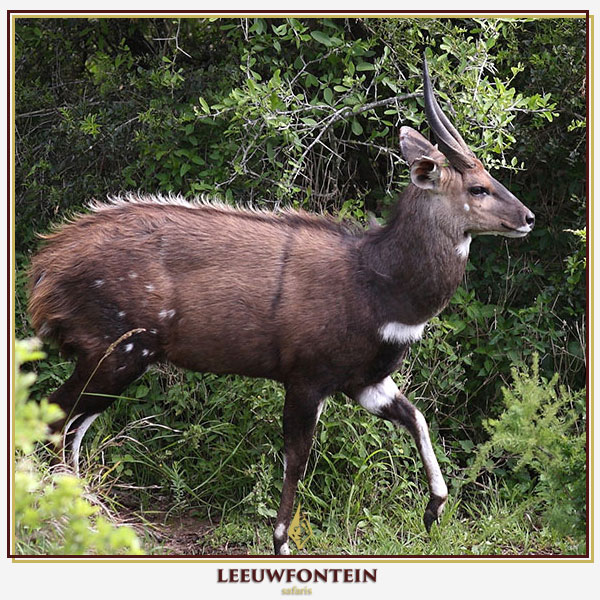The bushbuck (Tragelaphus scriptus) is a medium-sized antelope widely distributed across sub-Saharan Africa, including South Africa. Renowned for its elusive nature and striking appearance, the bushbuck presents a unique challenge for hunters. This comprehensive profile explores the physical characteristics, trophy measurements, behavior, habitat, hunting strategies, recommended equipment, shot placement, and ethical hunting practices associated with pursuing the bushbuck in South Africa.?
Bushbucks exhibit significant variation in size and coloration across their range. In South Africa, adult males typically stand about 79 centimeters at the shoulder and weigh approximately 42 kilograms, while females are slightly smaller, standing around 69 centimeters and weighing about 28 kilograms.
The coat color of bushbucks varies from reddish-brown to dark brown, often darkening with age, especially in males. Distinctive white markings adorn their bodies, including spots on the rump, legs, base of the neck, and below the throat. These markings can vary in prominence among individuals. Males possess spiral-shaped horns with a single twist, starting to grow at about 10 months of age and reaching lengths of 12 to 16 inches in mature individuals.
For hunters aiming to achieve trophy status, the Rowland Ward system sets specific minimum measurements for bushbuck horns. Traditionally, a minimum horn length of 15 inches was required; however, recent updates have adjusted this minimum to 14 inches. The Safari Club International (SCI) scoring system also recognizes trophy bushbucks, with a minimum score of 33 inches, calculated by adding the length of each horn and the circumference of their bases.
Bushbucks are predominantly solitary animals, exhibiting shy and elusive behavior. They prefer dense vegetation, such as riverine forests, dense thickets, and areas near water sources, which provide both food and cover. Primarily nocturnal, bushbucks are most active during the early morning and late afternoon, venturing out to feed on leaves, grass, branches, flowers, and fruit. When alarmed, they emit a loud, hoarse, dog-like bark to alert other animals of potential danger
Hunting bushbuck requires a blend of patience, stealth, and tactical precision due to their secretive nature and the dense habitats they occupy. Several effective strategies include:
Stalking and Spotting: Utilizing high-quality binoculars to glass likely areas during early morning or late afternoon can help locate bushbucks as they emerge to feed. Once spotted, a careful and calculated approach is necessary to close the distance without alerting the animal.
Still-Hunting:This method involves moving slowly and quietly through the bush, pausing frequently to scan for bushbucks. Given their preference for dense cover, hunters must be vigilant and attentive to subtle movements or sounds that may indicate the presence of a bushbuck.
Ambush Hunting:Setting up near known feeding areas or game trails can be effective, especially when wind direction and natural concealment are considered. This passive approach relies on the bushbuck moving into the hunter's vicinity, requiring patience and minimal movement.
Selecting appropriate equipment is crucial for a successful and ethical bushbuck hunt:
Caliber Recommendations:
A rifle chambered in .243 Winchester, 7×57 Mauser, or .308 Winchester with heavy bullets is preferable for bushbuck hunting. These calibers provide a balance between manageable recoil and sufficient stopping power. ?
Rifle Considerations:
A lightweight, accurate, bolt-action rifle is ideal for maneuvering through dense vegetation and ensuring precise shot placement.
Ammunition:
Premium-quality, controlled-expansion bullets are recommended to ensure adequate penetration and a humane kill.
Ethical hunting practices are paramount when pursuing bushbuck:
Shot Placement:
The optimal target is the vital zone encompassing the heart and lungs. A broadside shot just behind the shoulder is recommended to ensure a quick and humane kill.
Follow-up Shots:
Hunters should be prepared for a follow-up shot if the initial shot does not result in an immediate kill. Bushbucks can be tenacious, and a wounded animal may retreat into dense cover, making retrieval challenging.
Safety and Field Ethics:
Given the bushbuck's elusive nature and the environments they inhabit, hunters must exercise caution to avoid accidents. Additionally, respecting hunting regulations, obtaining necessary permits, and practicing fair chase principles are essential components of ethical hunting.
The bushbuck (Tragelaphus scriptus) is a captivating and challenging quarry for hunters in South Africa. Its solitary behavior, preference for dense habitats, and keen senses demand a high level of skill, patience, and respect from those who pursue it. By understanding its physical characteristics, behavior, and employing appropriate hunting strategies and equipment, hunters can engage in a rewarding and ethical pursuit of this remarkable antelope.? en.wikipedia.org +3

| # | NAME | |
| 1. | Species List | |